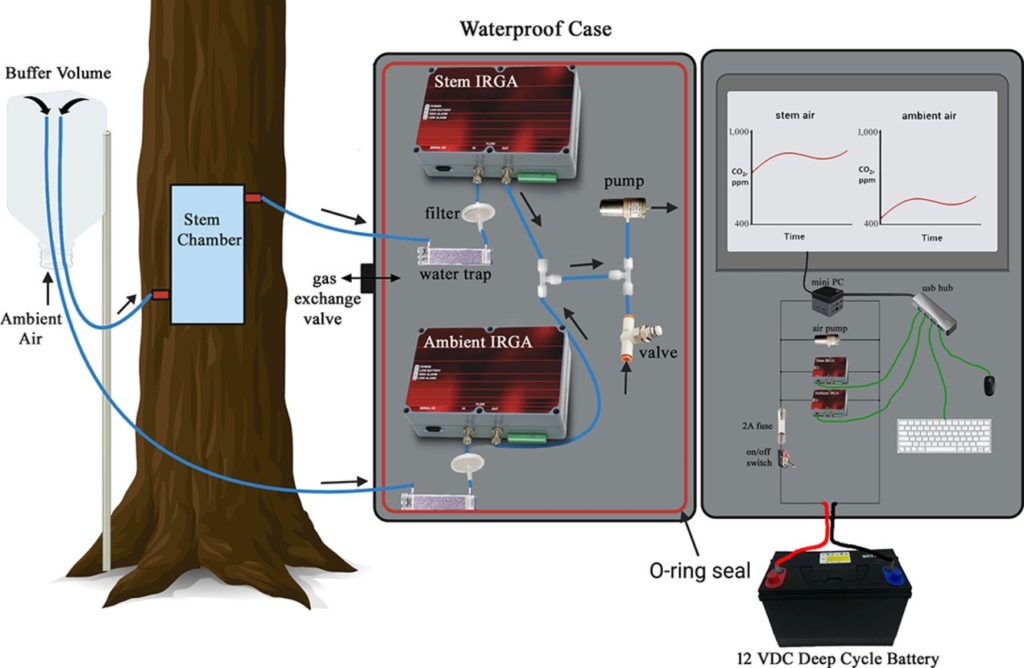The Science
Stem respiration is a quantitatively important, but poorly understood component of ecosystem carbon cycling in terrestrial ecosystems. However, a dynamic stem gas exchange system for quantifying real-time stem carbon dioxide (CO2) efflux (Es) is not commercially available resulting in limited observations based on the static method where air is recirculated through a stem enclosure. The static method has limited temporal resolution, suffers from condensation issues, requires a leak-free enclosure, which is often difficult to verify in the field, and requires physically removing the chamber or flushing it with ambient air before starting each measurement. Here we present the design of a custom system for real-time off the grid monitoring of stem CO2 efflux from diverse tropical forests.
The Impact
The system is low cost, lightweight, and waterproof with low power requirements (1.2-2.4 W) for real-time monitoring of stem Esusing a 3D printed dynamic stem chamber and a 12V car battery. Great success was achieved with this system in the Amazon during the rainy season in 2022. This method allows for the use of real-time stem CO2 efflux measurements to evaluate diurnal patterns of growth and respiration in hyper diverse forests to help resolve some major uncertainties surrounding stem respiration. While temperature is assumed to stimulate growth and its associated respiratory processes, preliminary real-time diurnal data collected with the technique suggest that plant hydraulics are also key, with mid-day water stress in the dry season limiting plant growth and respiratory process. The deployment of the techniques to remote tropical forests in Brazil will allow us to link plant hydraulics and carbon metabolism in ecosystem demographics models like FATES.
Summary
Stem respiration is a quantitatively important, but poorly understood component of ecosystem carbon cycling in terrestrial ecosystems. However, a dynamic stem gas exchange system for quantifying real-time stem carbon dioxide (CO2) efflux (Es) is not commercially available resulting in limited observations based on the static method where air is recirculated through a stem enclosure. The static method has limited temporal resolution, suffers from condensation issues, requires a leak-free enclosure, which is often difficult to verify in the field, and requires physically removing the chamber or flushing it with ambient air before starting each measurement.
With the goal of improving our quantitative understanding of biophysical, physiological, biochemical, and environmental factors that influence diurnal Espatterns, here we present a custom system for quantifying real-time stem Esin remote tropical forests. The system is low cost, lightweight, and waterproof with low power requirements (1.2-2.4 W) for real-time monitoring of stem Esusing a 3D printed dynamic stem chamber and a 12V car battery. The design offers control over the flow rate through the stem chamber, eliminates the need for a pump to introduce air into the chamber, and water condensation issues by removing water vapor prior to CO2analysis. Following a simple CO2infrared gas analyzer (IRGA) calibration and match procedure with a 400-ppm standard, we quantified diurnal Esobservations over a 24-hours period during the summer growing season from an ash tree (Fraxinus sp.) in Fort Collins, Colorado. The results are consistent with previous laboratory and field studies that show Es can be suppressed during the day relative to the night.

Contact: Kolby Jardine, Research Scientist, LBNL: Earth and Environmental Sciences Area, Ecology Department (kjjardine@lbl.gov)
Funding
Support for this research was provided as part of the Next Generation Ecosystem Experiments-Tropics (NGEE-Tropics) funded by the U.S. Department of Energy, Office of Science, Office of Biological and Environmental Research through contract No. DE-AC02-05CH11231 to LBNL, as part of DOE’s Terrestrial Ecosystem Science Program. We kindly acknowledge Christina Wistrom for her support at the UC Berkeley Oxford Tract Greenhouse where the method was developed and Bryan Taylor at LBNL for support with computer systems and software.
Publication: Jardine, K., Augusto, E., Levine, S. D., Sunder, A., Som, S., & Chambers, J. (2023). Development of a lightweight, portable, waterproof, and low power stem respiration system for trees. MethodsX, 10, 101986. https://doi.org/10.1016/j.mex.2022.101986.